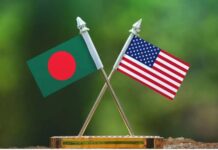“See China as an opportunity, not a threat,” says one of Modi’s top economists

Prime minister Narendra Modi’s trip to Wuhan for a summit with Chinese president Xi Jinping has been preceded by much VIP air traffic between Beijing and New Delhi.
Since late last year, an assortment of ministers, mandarins, and other sundry officials have flown across the Himalayas—the site of a months-long face-off between Indian and Chinese troops in 2017—to prepare the stage for a so-called “reset” in relations. The list of fliers includes Rajiv Kumar, the Oxford-trained economist who is vice-chairman of Niti Aayog, the Modi government’s main policy think-tank.
Early in April, Kumar met with He Lifeng, chairman of the National Development and Reform Commission, China’s economic planning body. The meetings, held in Beijing, were part of the India-China Strategic Economic Dialogue that began in 2011 at the behest of former Chinese premiere Wen Jiabao but were suspended last year following the Doklam incident.
Despite the unease over Beijing’s increasingly aggressive posturing on India’s borders and elsewhere in the region, Kumar’s takeaway is clear: look at China as an opportunity, not as a threat.
“A lot of conversation in India is about perceiving China as a threat to our entrepreneurs, to our markets, to our security…It’s certainly not the helpful way of looking at it. It may not even be the right way of looking at it,” Kumar told Quartz in an interview earlier this week. “…see them as an opportunity and not as a threat.”
“Because the conversation there—and maybe because they talk from a position of strength—is much about how to make use of the Indian market, how to build better ties, engage, and so on,” added Kumar, who took over Niti Aayog’s charge from Columbia University economist Arvind Panagariya last September.
The Chinese enthusiasm for the Indian market is understandable. China is India’s largest trading partner, even ahead of the US by some distance. Bilateral trade between India and China hit a record high of $84.4 billion in 2017, although skewed heavily in China’s favour. More than $20 billion of cheap Chinese electronics and IT products flow into India each year, pushing up India’s trade deficit with it to $57.9 billion between April 2017 and February 2018.
There’s no easy fix for this, especially given the long-running border dispute between the countries and, more recently, India’s concerns over president Xi’s ambitious One Belt One Road (OBOR) plan, now known as the Belt and Road Initiative (BRI). But Kumar insists that both sides are now seeing past these irritants.
“I think there is now surely a recognition in India that our northern neighbour has to be engaged, and this engagement can be successful, along with taking care of our core interests,” he said, outlining the Indian stance, which has softened since last year.
Beijing, too, seems to have pulled back. “They understand this, that these are India’s core interests…So that, you know, even when the question of OBOR or BRI is raised, your response is accepted. There is no more argument about it. There’s no, sort of, reproach,” Kumar explained, speaking of his Chinese counterpart.
Indeed, India did not support the proposed BRI at a meeting of foreign ministers of the eight-member Shanghai Cooperation Organisation this week, despite the political capital president Xi’s has personally invested in it.
“They (the Chinese) extol the virtues of BRI and you say that, ‘Look, this doesn’t gel with our own sovereignty and core interests,’ and that is that,” Kumar added.
Kumar’s assessment of a newfound Chinese flexibility on India’s reticence over the BRI, and New Delhi’s willingness to make concessions despite the border irritation, could mean that the two Asian powers have a window of opportunity.
“The two countries and economies are big enough to have several other points of contact and interaction, than through this BRI,” Kumar said. “So, therefore, there is convergence and I think there is a strong desire on both sides to improve economic and commercial ties. And that’s reflected now in what’s unfolding.”
But analysts are skeptical. “Despite all the positive messaging in both capitals, there’s no reason to believe that China and India will have a strategic reset anytime soon. No matter what comes out of the Modi-Xi summit, India and China are destined to remain strategic rivals,” said Michael Kugelman, deputy director of the Asia Program at the Wilson Center, a Washington DC-based think-tank.
Both countries remain locked in a competition for influence and natural resources, Kugelman argued, although neither side wants the relationship to deteriorate given the size of bilateral trade and a range of security-related concerns.
“What we’ve seen in recent months, and what we’re seeing with this summit, is a mutual desire to lower temperatures and create enough goodwill to ensure that the relationship is workable and relatively cordial, and not dysfunctional and hostile,” he said. “But an apparent détente shouldn’t be mistaken for a reset.”









